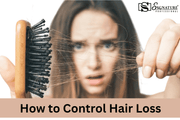
Hair loss is one of the most common concerns for both men and women. Whether it’s hair thinning, excessive shedding, or bald patches, losing hair can affect your confidence and self-esteem.
In Pakistan, heat, pollution, stress, and nutritional deficiencies make hair fall even more common. The good news? Most types of hair loss can be controlled and, in many cases, reversed with the right care and treatment.
This guide will walk you through:
-
Common causes of hair loss
-
Different types of hair loss (and why they matter)
-
How to prevent and stop hair loss naturally
-
Best treatments, products, and supplements
Understanding Hair Loss
Hair loss (or alopecia) refers to the shedding or thinning of hair from the scalp or body. It’s normal to lose 50–100 strands daily, but if you notice excessive hair on your pillow, comb, or shower drain, it may be time to take action.
Common Causes of Hair Loss
-
Genetics (Androgenetic Alopecia) – Hereditary pattern baldness is the most common cause.
-
Hormonal Changes – Pregnancy, menopause, PCOS, or thyroid issues can trigger hair loss.
-
Nutritional Deficiency – Low levels of iron, zinc, vitamin D, or protein can weaken hair roots.
-
Stress & Lifestyle – Chronic stress and lack of sleep can push hair into shedding phase.
-
Medical Conditions – Autoimmune disorders like alopecia areata, scalp infections, or chronic illness.
-
Hair Styling & Chemical Damage – Frequent heat styling, bleaching, or tight hairstyles cause breakage.
-
Medications & Treatments – Certain medicines, including chemotherapy, can trigger hair loss.
Types of Hair Loss
-
Androgenetic Alopecia – Gradual thinning, more common in men (“male pattern baldness”).
-
Telogen Effluvium – Temporary hair shedding after stress, illness, or pregnancy.
-
Alopecia Areata – Patchy bald spots due to autoimmune response.
-
Traction Alopecia – Caused by tight hairstyles pulling on hair roots.
How to Prevent Hair Loss
-
Choose a Gentle Shampoo: Avoid harsh sulfates; use a mild, nourishing shampoo.
-
Condition Regularly: Keep hair moisturized to prevent breakage.
-
Avoid Tight Hairstyles: Switch to loose styles to protect your roots.
-
Reduce Heat Styling: Limit blow drying and straightening — always use heat protectant.
-
Scalp Care: Exfoliate monthly and massage with oils like rosemary or coconut oil to boost circulation.
-
Manage Stress: Practice yoga, meditation, or breathing exercises.
Best Hair Loss Treatments
-
Topical Treatments: Minoxidil (consult a dermatologist before use).
-
Prescription Medications: Finasteride for men (only under medical supervision).
-
Hair Growth Shampoos & Serums: Look for ingredients like biotin, caffeine, and peptides.
-
Supplements: Iron, zinc, vitamin D, and omega-3 fatty acids support healthy hair growth.
-
PRP Therapy: Platelet-rich plasma injections to stimulate hair follicles.
-
Hair Transplant: A long-term surgical solution for severe baldness.
Home Remedies for Hair Loss
-
Coconut Oil Massage: Strengthens roots and prevents protein loss.
-
Onion Juice: Rich in sulfur, promotes regrowth.
-
Aloe Vera: Soothes scalp and reduces dandruff.
-
Egg Mask: Adds protein, making hair stronger and shinier.
Diet for Healthy Hair
-
Protein: Eggs, fish, chicken, lentils
-
Iron: Spinach, beans, red meat
-
Vitamin D: Sunlight, fortified milk
-
Zinc: Nuts, seeds, whole grains
-
Omega-3: Walnuts, chia seeds, salmon
Hair Loss in Men vs. Women
-
Men: More likely to experience male pattern baldness, starting at the hairline or crown.
-
Women: Experience diffuse thinning across the scalp, often triggered by hormonal imbalance or postpartum shedding.
When to See a Doctor
Seek professional help if:
-
Hair loss is sudden or patchy.
-
You notice scalp redness, itching, or scaling.
-
Hair fall continues for more than 3 months despite lifestyle changes.
Frequently Asked Questions
Q1: How much hair fall is normal per day?
Ans: 50–100 strands are normal. Anything beyond that may indicate an underlying issue.
Q2: Can hair loss be reversed?
Ans: Yes, if treated early and the root cause is addressed.
Q3: What is the best shampoo for hair loss?
Ans: Look for sulfate-free, biotin-infused, or caffeine-based shampoos.
Q4: Does stress cause hair loss?
Ans: Yes, chronic stress can trigger telogen effluvium, leading to excessive shedding.
Final Thoughts
Hair loss can feel overwhelming, but with the right approach, you can slow it down and even encourage regrowth. Build a healthy hair care routine, address nutritional deficiencies, and seek expert help if needed.
Remember, early intervention is key. The sooner you start caring for your scalp and strands, the better your chances of maintaining thick, healthy hair.









